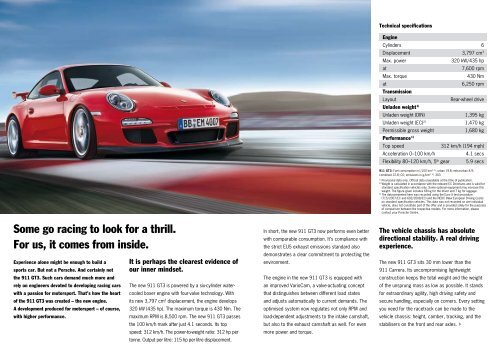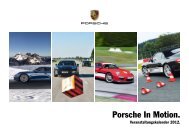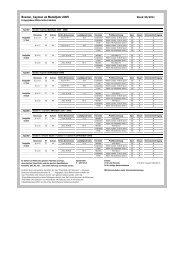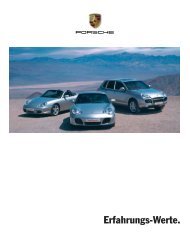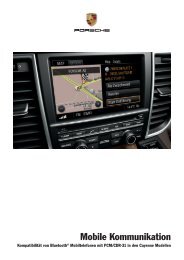Porschenews 01/2009 Go your own way. The new Cayman.
Porschenews 01/2009 Go your own way. The new Cayman.
Porschenews 01/2009 Go your own way. The new Cayman.
Create successful ePaper yourself
Turn your PDF publications into a flip-book with our unique Google optimized e-Paper software.
Some go racing to look for a thrill.<br />
For us, it comes from inside.<br />
Experience alone might be enough to build a<br />
sports car. But not a Porsche. And certainly not<br />
the 911 GT3. Such cars demand much more and<br />
rely on engineers devoted to developing racing cars<br />
with a passion for motorsport. That’s how the heart<br />
of the 911 GT3 was created – the <strong>new</strong> engine.<br />
A development produced for motorsport – of course,<br />
with higher performance.<br />
It is perhaps the clearest evidence of<br />
our inner mindset.<br />
<strong>The</strong> <strong>new</strong> 911 GT3 is powered by a six-cylinder water-<br />
cooled boxer engine with four-valve technology. With<br />
its <strong>new</strong> 3,797 cm 3 displacement, the engine develops<br />
320 kW (435 hp). <strong>The</strong> maximum torque is 430 Nm. <strong>The</strong><br />
maximum RPM is 8,500 rpm. <strong>The</strong> <strong>new</strong> 911 GT3 passes<br />
the 100 km/h mark after just 4.1 seconds. Its top<br />
speed: 312 km/h. <strong>The</strong> power-to-weight ratio: 312 hp per<br />
tonne. Output per litre: 115 hp per litre displacement.<br />
In short, the <strong>new</strong> 911 GT3 now performs even better<br />
with comparable consumption. It’s compliance with<br />
the strict EU5 exhaust emissions standard also<br />
demonstrates a clear commitment to protecting the<br />
environment.<br />
<strong>The</strong> engine in the <strong>new</strong> 911 GT3 is equipped with<br />
an improved VarioCam, a valve-actuating concept<br />
that distinguishes between different load states<br />
and adjusts automatically to current demands. <strong>The</strong><br />
optimised system now regulates not only RPM and<br />
load-dependent adjustments to the intake camshaft,<br />
but also to the exhaust camshaft as well. For even<br />
more power and torque.<br />
Technical specifications<br />
Engine<br />
Cylinders 6<br />
Displacement 3,797 cm 3<br />
Max. power 320 kW/435 hp<br />
at 7,600 rpm<br />
Max. torque 430 Nm<br />
at 6,250 rpm<br />
Transmission<br />
Layout Rear-wheel drive<br />
Unladen weight 1)<br />
Unladen weight (DIN) 1,395 kg<br />
Unladen weight (EC) 2) 1,470 kg<br />
Permissible gross weight 1,680 kg<br />
Performance 1)<br />
Top speed 312 km/h (194 mph)<br />
Acceleration 0–100 km/h 4.1 secs<br />
Flexibility 80–120 km/h, 5 th gear 5.9 secs<br />
911 GT3: Fuel consumption in l/100 km 1), 3) : urban 19.8; extra-urban 8.9;<br />
combined 12.8; CO 2 emissions in g/km 1), 3) : 303<br />
1) Provisional data only. Official data unavailable at the time of publication.<br />
2) Weight is calculated in accordance with the relevant EC Directives and is valid for<br />
standard specification vehicles only. Some optional equipment may increase this<br />
weight. <strong>The</strong> figure given includes 68 kg for the driver and 7 kg for luggage.<br />
3) <strong>The</strong> data presented here was recorded using the Euro 5 test procedure<br />
(715/2007/EC and 692/2008/EC) and the NEDC (New European Driving Cycle)<br />
on standard specification vehicles. This data was not recorded on one individual<br />
vehicle, does not constitute part of the offer and is provided solely for the purposes<br />
of comparison between the respective models. For more information, please<br />
contact <strong>your</strong> Porsche Centre.<br />
<strong>The</strong> vehicle chassis has absolute<br />
directional stability. A real driving<br />
experience.<br />
<strong>The</strong> <strong>new</strong> 911 GT3 sits 30 mm lower than the<br />
911 Carrera. Its uncompromising lightweight<br />
construction keeps the total weight and the weight<br />
of the unsprung mass as low as possible. It stands<br />
for extraordinary agility, high driving safety and<br />
secure handling, especially on corners. Every setting<br />
you need for the racetrack can be made to the<br />
vehicle chassis: height, camber, tracking, and the<br />
stabilisers on the front and rear axles.


